Future of Nuclear Safety

T
he direction of future nuclear safety research efforts is anybody's guess. Historically, there has been the trend that as knowledge and experience of nuclear reactor technology has increased, emphasis has shifted from reliance on containment structures to safety through the improved design of the reactor plant itself. This trend will likely continue. Ultimately, the future of any science is defined by the needs of the present. Probably the primary issue that needs to be addressed is the need to assure the public that nuclear power technology is safe and needed. The advanced light water reactor designs significantly reduced the probably of a severe accident and include inherent safety mechanisms which reduce the opportunity of human error. Such improvements will go a long way toward securing nuclear power as a technically safe electrical generation source. Unfortunately, addressing the issue of public concern is as much technical as it is political. Advances in nuclear safety alone will do little to change public opinion; however, neglecting nuclear safety research could result in a huge loss of public confidence in this industry.
Another factor that will affect the future of nuclear safety is economics. As governments deregulate the power industry, competition will force utilities to operate as efficient as possible. The goal that nuclear power plants compete economically with conventional (fossil fuel) plants will continue to create strong pressures to reduce capital costs, to increase reactor power levels, to lengthen core life, to achieve more efficient performance, and to bring reactors closer to metropolitan areas. The direction of many of these forces may appear counter to reactor safety. However, steady advances in the technology have made it possible to replace some of the very conservative safety measures, taken originally because of ignorance, by more realistic and, at the same time, more economic measures.
Goals of Reactor Safety
Ultimately, the goal of reactor safety is to reduce the likelihood of a threatening situation caused by the operation of a nuclear power plant to the absolute lowest degree possible. Specifically, this goal translates into four subgoals:
1. Public Safety - There must be no release of radioactive material in dangerous quantities from a nuclear facility to the general public.
2. Industrial Personnel - Every reasonable effort should be made to eliminate accidents involving plant employees. The frequency of such events should be reduced to the lowest possible level, certainly lower than that of other comparable industries.
3. Economic - The likelihood of a serious accident which would result in severe damage to the nuclear facility should be kept as small as possible.
4. Operational Problems - System malfunctions and deviations from normal behavior should be reduced to a minimum.
Historically, governments have been primarily concerned with public and personnel safety; hence, nuclear safety research sponsored by government agencies is more likely to address these issues. Operating groups - utilities and vendors - support a broad sponsorship in all four areas. Again, this trend will likely continue.
Prospects on the Growth of the Nuclear Power Industry
The crystal-ball is a bit fuzzy on this subject. In some parts of the world nuclear power has been embraced and, at the same time, rejected. Many factors have played a part in this response. In those countries that have embraced nuclear power, these countries tend to have limited oil and gas reserves, a desire to be economic independent, and/or a desire to reduce air pollutants. Countries that have rejected nuclear power have done so out of concern over safety, economics, and the environment. Coincidently, these countries tend to be rich in other natural resources.
The nuclear industry still has a ways to go to firmly establish itself in the minds of the public. Nuclear safety efforts will play a significant role whether it is successful.